The AMD Radeon R9 Fury Review, Feat. Sapphire & ASUS
by Ryan Smith on July 10, 2015 9:00 AM ESTMeet The Sapphire Tri-X R9 Fury OC
Today we’ll be looking at Fury cards from both Sapphire and Asus. We’ll kick things off with Sapphire’s card, the Tri-X R9 Fury OC.
| Radeon R9 Fury Launch Cards | |||||
| ASUS STRIX R9 Fury | Sapphire Tri-X R9 Fury | Sapphire Tri-X R9 Fury OC | |||
| Boost Clock | 1000MHz / 1020MHz (OC) |
1000MHz | 1040MHz | ||
| Memory Clock | 1Gbps HBM | 1Gbps HBM | 1Gbps HBM | ||
| VRAM | 4GB | 4GB | 4GB | ||
| Maximum ASIC Power | 216W | 300W | 300W | ||
| Length | 12" | 12" | 12" | ||
| Width | Double Slot | Double Slot | Double Slot | ||
| Cooler Type | Open Air | Open Air | Open Air | ||
| Launch Date | 07/14/15 | 07/14/15 | 07/14/15 | ||
| Price | $579 | $549 | $569 | ||
Sapphire is producing this card in two variants, a reference clocked version and a factory overclocked version. The version we’ve been sampled is the factory overclocked version, though other than some basic binning to identify cards that can handle being overclocked, the two cards are physically identical.
As far as Sapphire’s overclock goes, it’s a mild overclock, with the card shipping at 1040MHz for the GPU while the memory remains unchanged at 1Gbps. As we discussed in our R9 Fury X review, Fiji cards so far don’t have much in the way of overclocking headroom, so AMD’s partners have to take it easy on the factory overclocks. Sapphire’s overclock puts the upper-bound of any performance increase at 4% – with the real world gains being smaller – so this factory overclock is on the edge of relevance.
Getting down to the nuts and bolts then, Sapphire’s card is a semi-custom design, meaning Sapphire has paired an AMD reference PCB with a custom cooler. The PCB in question is AMD’s PCB from the R9 Fury X, so there’s little new to report here. The PCB itself measures 7.5” long and features AMD’s 6 phase power design, which is designed to handle well over 300W. For overclockers there is still no voltage control options available for this board design, though as Sapphire has retained AMD’s dual BIOS functionality there’s plenty of opportunity for BIOS modding.
The real story here is Sapphire’s Tri-X cooler, which gets the unenviable job of replacing AMD’s closed loop liquid cooler from the R9 Fury X. With a TBP of 275W Sapphire needs to be able to dissipate quite a bit of heat to keep up with Fiji, which has led to the company using one of their Tri-X coolers. We’ve looked at a few different Tri-X cards over the years, and they have been consistently impressive products. For the Tri-X R9 Fury, Sapphire is aiming for much the same.
Overall the Tri-X cooler used on the Tri-X R9 Fury ends up being quite a large cooler. Measuring a full 12” long it runs the length of the PCB and then some, meanwhile with that much copper and aluminum it’s not a light card either. The end result is that with such a large cooler the card is better defined as a PCB mounted on a cooler than a cooler mounted on a PCB, an amusing juxtaposition from the usual video card. As a result of this Sapphire has gone the extra mile to ensure that the PCB can support the cooler; there are screws in every last mounting hole, there’s a full-sized backplate to further reinforce the card, and the final 4.5” of the cooler that isn’t mounted to the PCB has its own frame to keep that secure as well.
Moving to the top of the card, the Tri-X R9 Fury features three of Sapphire’s 90mm “Aerofoil” fans, the company’s larger, dual ball bearing fans. These fans are capable of moving quite a bit of air even when moving at relatively low speeds, and as a result the overall card noise is kept rather low even under load, as we’ll see in full detail in our benchmark section.
Meanwhile Sapphire has also implemented their version of zero fan speed idle on the Tri-X R9 Fury, dubbed Intelligent Fan Control, which allows the card to turn off its fans entirely when their cooling capacity isn’t needed. With such a large heatsink the Fiji GPU and supporting electronics don’t require active cooling when idling, allowing Sapphire to utilize passive cooling and making the card outright silent at idle. This is a feature a number of manufacturers have picked up on in the last couple of years, and the silent idling this allows is nothing short of amazing. For Sapphire’s implementation on the Tri-X R9 Fury, what we find is that the fans finally get powered up at around 53C, and power down when the temperature falls below 44C.
| Sapphire Tri-X R9 Fury Zero Fan Idle Points | ||||
| GPU Temperature | Fan Speed | |||
| Turn On | 53C | 27% | ||
| Turn Off | 44C | 23% | ||
Helping the cooling effectiveness of the Tri-X quite a bit is the length of the fans and heatsink relative to the length of the PCB. With the 4.5” of overhang, the farthest fan is fully beyond the PCB. That means that all of the air it pushes through the heatsink doesn’t get redirected parallel to the card – as is the case normally for open air cards – but rather the hot air goes straight through the heatsink and past it. For a typical tower case this means that hot air goes straight up towards the case’s exhaust fans, more efficiently directing said hot air outside of the case and preventing it from being recirculated by the card’s fans. While this doesn’t make a night & day difference in cooling performance, it’s a neat improvement that sidesteps the less than ideal airflow situation the ATX form factor results in.
Moving on, let’s take a look at the heatsink itself. The Tri-X’s heatsink runs virtually the entire length of the card, and is subdivided into multiple segments. Connecting these segments are 7 heatpipes, ranging in diameter between 6mm and 10mm. The heatpipes in turn run through both a smaller copper baseplate that covers the VRM MOSFETs, and a larger copper baseplate that covers the Fiji GPU itself. Owners looking to modify the card or otherwise remove the heatsink will want to take note here; we’re told that it’s rather difficult to properly reattach the heatsink to the card due to the need to perfectly line up the heatsink and mate it with the GPU and the HBM stacks.
The Tri-X R9 Fury’s load temperatures tend to top out at 75C, which is the temperature limit Sapphire has programmed the card for. As with the R9 Fury X and the reference Radeon 290 series before that, Sapphire is utilizing AMD’s temperature and fan speed target capabilities, so while the card will slowly ramp up the fan to 75C, once it hits that temperature it will more greatly ramp up the fan to keep the temperature at or below 75C.
Moving on, since Sapphire is using AMD’s PCB, this means the Tri-X also inherits the former’s BIOS and lighting features. The dual-BIOS switch is present, and Sapphire ships the card with two different BIOSes. The default BIOS (switch right) uses the standard 300W ASIC power limit and 75C temperature target. Meanwhile the second BIOS (switch left) Increases the power and temperature limits to 350W and 80C respectively, for greater overclocking limits. Note however that this doesn’t change the voltage curve, so Fury cards in general will still be held back by a lack of headroom at stock voltages. As for the PCB’s LEDs, Sapphire has retained those as well, though they default to blue (sapphire) rather than AMD red.
Finally, since this is the AMD PCB, display I/O remains unchanged. This means the Tri-X offers 3x DisplayPorts along with a single HDMI 1.4 port.
Wrapping things up, the OC version we are reviewing today will retail for $569, $20 over AMD’s MSRP. The reference clocked version on the other hand will retail at AMD’s MSRP of $549, the only launch card that will be retailing at this price. Finally, Sapphire tells us that the OC version will be the rarer of the two due to its smaller run, and that the majority of Tri-X R9 Fury cards that will be on sale will be the reference clocked version.


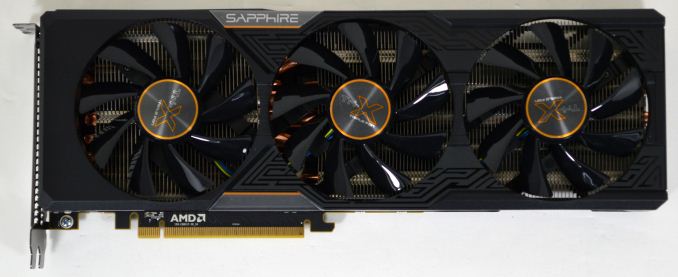
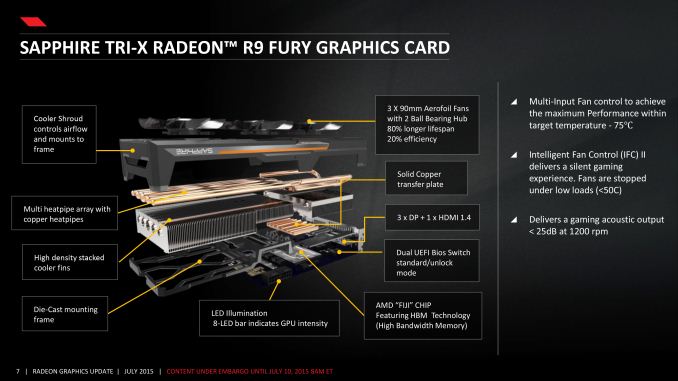
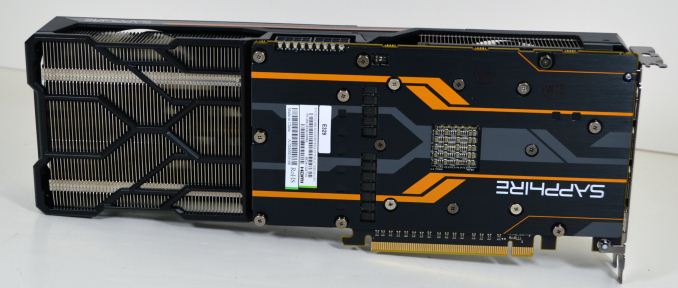
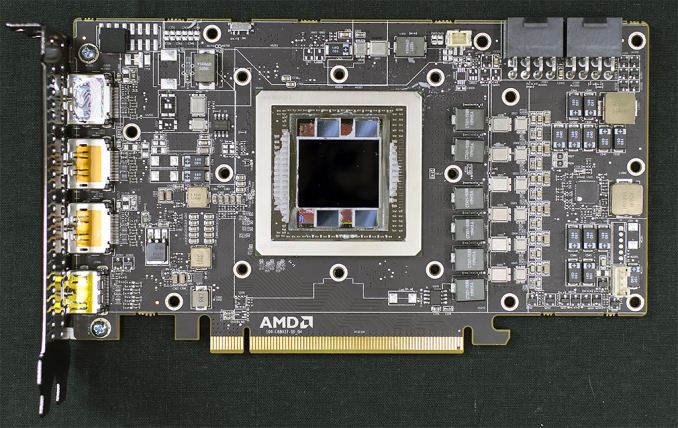


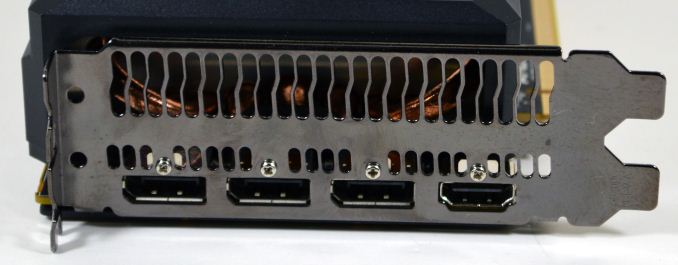








288 Comments
View All Comments
CiccioB - Monday, July 13, 2015 - link
The myth, here again!Let's see these numbers of a miraculous vs crippling driver.
And I mean I WANT NUMBNERS!
Or what you are talking about is just junk you are reporting because you can't elaborate yourself.
Come on, the numbers!!!!!!!!!
FlushedBubblyJock - Thursday, July 16, 2015 - link
So you lied loguerto, but the sad truth is amd bails on it's cards and drivers for them FAR FAR FAR sooner than nvidia does.YEARS SOONER.
Get with it bub.
Count Vladimir - Thursday, July 16, 2015 - link
Hard evidence or gtfo.Roboyt0 - Sunday, July 12, 2015 - link
I am very interested to see how much of a difference ASUS' power delivery system will make for (real) overclocking in general once voltage control is available. If these cards act the same as the 290's did, then AMD's default VRM setup could very likely be more than capable of overclocks in the 25% or more range. I'm basing the 25% or more off of my experience with a half dozen reference based R9 290's, default 947MHz core, that would reach 1200 core clock with ~100mV additional. And if you received a capable card then you could surpass those clocks with more voltage.It appears AMD has followed the EXACT same path they did with the 290 and 290X. The 290X always held a slight lead in performance, but the # of GPU components disabled didn't hinder the 290 as much as anyone thought. This is exactly what we see now with the Fury ~VS~ Fury X...overclock the Fury and it's the better buy. All while the Fury X is there for those who want that little bit of extra performance for the premium, and this time you're getting water cooling! It seems like a pretty good deal to me.
Once 3rd party programmers(not AMD) figure out voltage control for these cards, history will likely repeat itself for AMD. Yes, these will run hotter and use more power than their Nvidia counterparts...I don't see why this is a shock to anyone since this is still 28nm and similar enough to Hawaii...What no one seems to mention is the amount of performance increase compared to Hawaii in the same power/thermal envelope..it's a very significant jump.
Whom in the enthusiast PC world really cares about the additional power draw? We're looking at 60-90W under normal load conditions; Furmark is NOT normal load. Unless electricity where you hail from is that expensive, it isn't actually costing you that much more in the long run. If you're in the market for a ~$550 GPU, then you probably aren't too concerned with buying a good PSU. What the FurMark power draw of the Fury X/Sapphire Fury really tell us is that the reference PCB is capable of handling 385W+ of draw. This should give an idea of what the card can do once we are able to control the voltage.
These cards are enthusiast grade and plenty of those users will remove the included cooler for maximum performance. A full cover waterblock is going to be the key to releasing the full potential of Fury(X) just like it was for 290(X). It is a definite plus to see board partners with solid air cooling solutions out of the gate though...Sapphire's cooling solution fares better in temperature AND noise during FurMark than ASUS' when it's pulling 130W additional power! Way to go Sapphire!
My rant will continue concerning drivers. Nvidia has mature hardware with mature drivers. The fact AMD is keeping up, or winning is some instances, is a solid achievement. Go back to a 290(X) review when their primary competition was a 780 Ti, where the 780 Ti was usually winning. Now, the 390(X), that so many are calling a rebranded POS, easily bests the 780 Ti and competes with GTX 980. Nvidia changed architecture, but AMD is still competitive? Another commenter said it best by saying: "An AMD GPU is like a fine wine, and gets better with age."
This tells me 3 things...
1) Once drivers mature, AMD stands to gain solid performance improvements.
2) Adding voltage control to enable actual overclocking will show the true potential of these cards.
3) Add these two factors together and AMD has another winning product.
Lastly we still have DX12 to factor into all of this. Sure, you can say DX12 is too far away, but in actuality it is not. I know there are those people who MUST HAVE the latest and greatest hardware every time something new comes around every ~9 months. However, there are plenty more of us who wait a few generations of GPUs to upgrade. If DX12 brings even a half of the anticipated performance gains and you're in the market, then purchasing this card now, or in the coming months, will be a solid investment for the coming years.
Peichen - Monday, July 13, 2015 - link
Whatever flats your boat. There are still some people like you that believes FX CPUs are faster than i7s and they are what keeps AMD afloat. The rest of us.... we actually consider everything and go Intel & Nvidia.There are 3 fails in your assumptions:
1. Fiji is a much bigger core tied to 4 HBM modules. OC will likely not be as "smooth" as 290X
2. 60-90W is not just cost in electricity. It is also getting a PSU that will supply the additional draw and more fan(s) and better case to get the heat out. Or suffer the heat and noise. The $15-45 a year in additional electricity bill also means you will be in the red in a couple od years.
3. You assume AMD/ATI driver team is still around and will be around a couple of years in the future.
silverblue - Tuesday, July 14, 2015 - link
3. Unless the driver work has been completely outsourced and there's proof of this happening, I'm not sure you can use this as a "fail".Fiji isn't a brand new version of GCN so I don't expect the huge gains in performance that are being touted, however whatever they do bring to the table should benefit Tonga as well, which will (hopefully) distance itself from Tahiti and perhaps improve sales further down the stack.
Count Vladimir - Thursday, July 16, 2015 - link
Honestly, driver outsourcing might be for the best in case of AMD.Oxford Guy - Wednesday, July 15, 2015 - link
The most electrically efficient 3D computer gaming via an ARM chip, right? Think of all the wasted watts for these big fancy GPUs. Even more efficient are text-based games.FlushedBubblyJock - Thursday, July 16, 2015 - link
You forgot he said spend a hundred and a half on a waterblock...for the amd card, for "full potential"..ROFL - once again the future that never comes is very bright and very expensive.
beck2050 - Monday, July 13, 2015 - link
A bit disingenuous as custom cooled over clocked 980s are the norm these days and easily match or exceed Fury, while running cooler with much less power and can be found cheaper. AMD HAS its work cut out.